Medieval peasants were a class of people somewhat shrouded in mystery—with many not knowing how to read or write, peasants weren’t good note-takers.
This has made it hard to study their lives over the years, but today, we have a greater understanding of every aspect of their lives, down to clothing, food and dress sense.
In this guide, we’ll take a look at the lives of medieval peasants, covering as broad a range of their lives possible, and focusing in particular on the peasantry of England.
The Importance Of Understanding How Medieval Peasants Lived
As writers, it’s so important to do our research. Some authors even go to the extent of living the role, which can be hard to do when writing fantasy, but as we’ll see, there are places you can visit, like the peasant village in Wales, to get a real feel of a medieval peasant’s life.
This just empowers you with knowledge that you can draw upon when writing your next fantasy novel or story, particularly if it has a medieval European setting, which so many fantasy stories have.
But doing the research is tough, and that’s why in other posts, I’ve compiled useful information on:
- Medieval weapons
- Armor
- The life of lords
- Medieval cannons
- Castles and keeps
- Archery
- Sieges
- Medieval diseases
Let’s dive into the lives of medieval peasants.
The Medieval Peasant
The term peasant is misleading. Although these people were at the bottom of the pyramidal feudal system that operated in England during the Middle Ages, they were nowhere near as brutish and stupid as the history books make them out to be.
In fact, all that ‘peasant’ really meant was that you lived off the produce of your own labour, that you were self-sufficient. No different from the allotment keepers and off-the-gridders around the world today.
Medieval peasants farmed the land to provide food for everyone else, working for a lord who let them farm a piece of land in exchange for labour and taxes.

Where better to look for an insight into the life of the peasant than from someone who lived during the era. Here’s a quote from 1395 from medieval author Jean Froissart:
“It is the custom in England, as with other countries, for the nobility to have great power over the common people, who are serfs. This means that they are bound by law and custom to plough the field of their masters, harvest the corn, gather it into barns, and thresh and winnow the grain; they must also mow and carry home the hay, cut and collect wood, and perform all manner of tasks of this kind.”
But despite this work-orientated account, medieval peasants had quite a lot of control over their lives. Some were chosen to sit on village councils or in local courts to deal with issues ranging from trivial boundary disputes to murders.
The lords, in short, couldn’t be arsed to get involved in these things. But this worked against them. The peasants grew savvy, learned the laws and how to read and write.
An example of the bright thinking of peasants can be seen in the year 1200. King John proposed a visit to Nottingham. To get there his route would take him right through the village of Gotham (not Batman). This meant it’d become a kings highway and therefore liable to more taxes.
The villagers of Gotham didn’t like this, so when the king’s messengers arrived the whole village pretended to be insane—madness was considered a contagious illness back then. When King John learned of this infested little town, he decided on a different route.
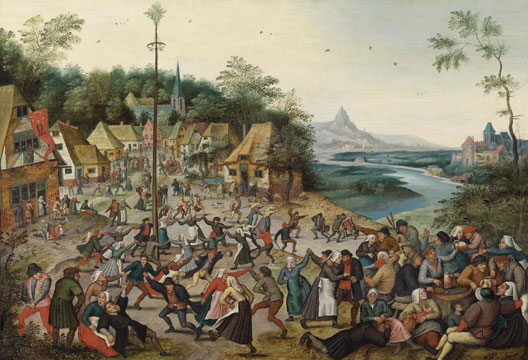
A Medieval Peasant’s House
Back in the Middle Ages, a village was known as a ‘vill’, which in Middle English translated to town. Vills could include small hamlets, scatterings of farms, or compact groups of houses too. The term vill was used to describe a unit of government too, the smallest unit of all.
Being made from a wooden frame and panelled with wattle (woven twigs) and daubed with mud, the early homes of medieval peasants did not stand the test of time. In fact, they lasted little more than twenty or thirty years.
The exterior walls were plastered with quicklime and earth to give it extra strength, and depending on the shade of the soil, left them with a white, yellow or reddish colour.

Peasant cottage, Cosmeston Medieval Village, Wales
Roofs were thatched, made from straw and reeds. Windows, of which there tended to be just one or two, lacked glass and just had shutters which allowed for draughts. The interior floor was just compacted earth or was covered with straw.
The shapes of houses varied depending on the culture. The Celts, for example, had roundhouses, whereas English peasants opted for something called a cruck house.
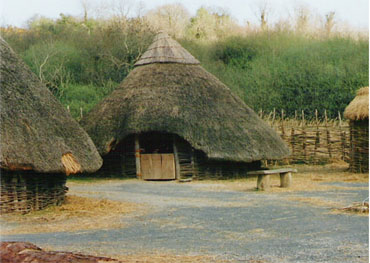
Most houses consisted of one room, though some had two, and some featured a mezzanine level of sorts, which usually housed the sleeping quarters of the youngsters.
The central feature was usually a fire. Early houses lacked a chimney so toxic fumes tended to circulate before escaping through cracks in windows or seeping through the thatch. It was a source of a lot of health problems, though when chimneys came about these decreased.
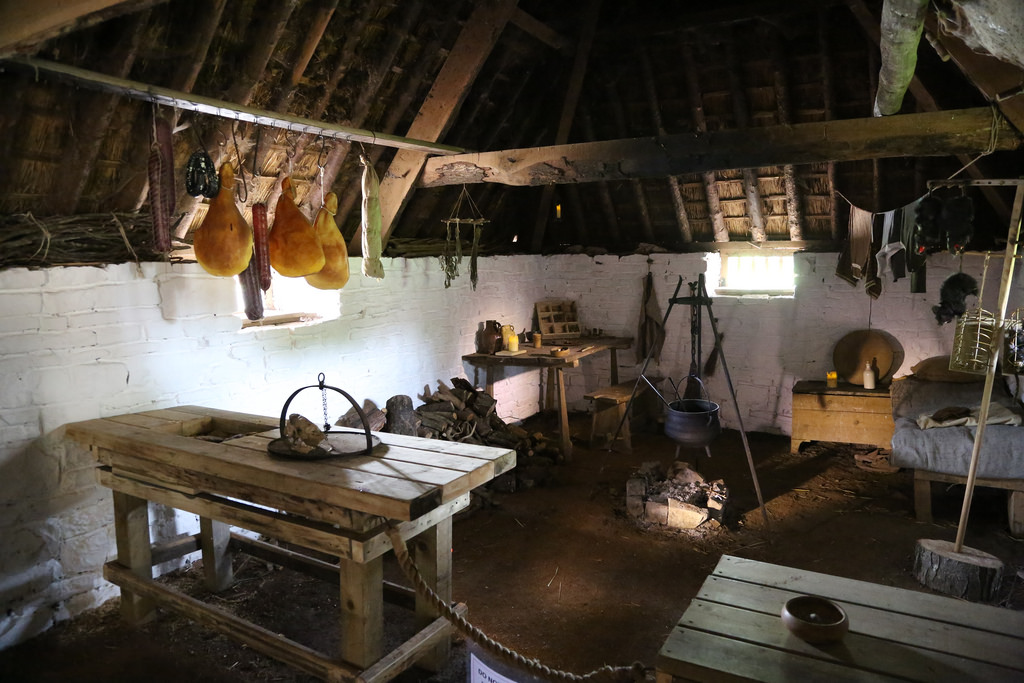
Interior of peasant cottage, Cosmeston Medieval Village, Wales
Furniture was basic: benches, stools, tables. Chairs were often too expensive. Chests were used to store possessions away and hooks were used for hanging things off the dirty ground. Beds were made from straw.
Peasants weren’t the only inhabitants of these houses. If they owned animals—pigs, oxen, chickens—they lived inside too. If they didn’t have a barn, where else were they to go? They were too valuable to risk losing. Outside they could wander off, be preyed upon by the wolves and bears that still roamed the forests of England, or be stolen by reprobates.
Just imagine the smells and the mess and the noise, let alone the fleas. A plant called fleabane was used by many peasants in their homes.
Not all peasant houses were like this. Medieval peasants of a higher standing, such as the reeve (the village manager), a peasant who quite often owned land, had more furniture and decorative items, such as pottery imported from France.
In the later medieval period, particularly after the Black Death when peasants found themselves with a little more coin than before, we begin to see houses made of half brick and half-timber.
In busier and bigger vills you could find townhouses. These were timber-framed with two floors. The ground floor was usually used as a shop front or workshop. Livestock was kept in there too. The second floor was used for living.
A big reception hallway was characteristic of a wealthy person; it was the first impression visitors got. A dining room was another main feature. Up until around 14th-century windows tended to be made of brown or green glass. Some townhouses, from around the 15th century onwards, had a latrine, which was a very crude toilet.
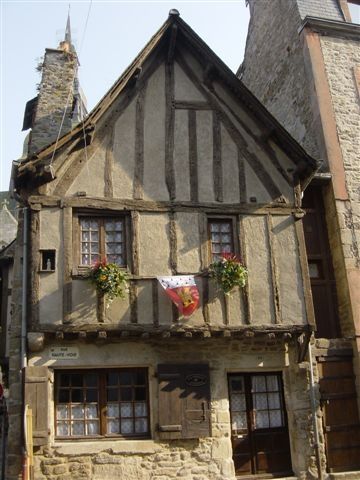
Each city differed, but most had characteristic traits. Most were found on rivers, coasts, or along trade routes. The market was the backbone of a medieval city, usually found in squares and close to a church.
Travelling merchants moved from city to city, selling their goods in markets. The streets would have been smelly. Faeces and waste were just tossed away wherever was convenient, i.e. rivers or the streets themselves. Complaints were made, but very little was done.

A Medieval Peasant‘s Food
Pottage was a popular dish, not by choice. The recipe for pottage involved taking anything you could find and putting it into a pan of water and allowing it to boil for two hours. Everything had to be boiled because human excrement was used in the fields as fertiliser. Herbs, spices and garlic helped the taste.
There was an instant form of pottage too. Pre-made pottage was made into a sort of bread and taken to the fields. Beer and mead were used to soak and break it up. Yes, beer.
Other examples of a medieval peasant’s food include:
- Breads
- Grains like rye and wheat
- Peas
- Beans
- Onions
- Berries
- Nuts
- Honey
Peasants generally didn’t eat much meat. It involved killing livestock that may be needed for other purposes, like tilling the land or milking.
What Did Medieval Peasants Drink?
Alcoholic drinks were preferred to water because the water wasn’t very drinkable. Many vills had communal latrine pits, which could, in time, seep into and contaminate water sources. Also, dumping waste in rivers tainted it too. So beer it was.
How Did Peasants Spend Their Time?
The social life of a peasant centred around church. Here they had parties and enjoyed plays and performances. The church also provided plenty of holy days, eighty a year! Nowadays we get just eight. What happened there?
As we saw in the video above, they played games like dice. And they were quite creative when it came to avoiding the taxes of King John.
How Hygienic Were Peasants?
Peasants didn’t bother cleaning themselves much. They’d be lucky to get one bath a year.
It was said that a peasant received two baths in their lifetime: once when born and the other when they died. There was no knowledge of hygiene.
Compare this to the Romans. They built public baths for the lower classes to use because they knew it reduced the rates of disease. Enlightened.
How Long Did Medieval Peasants Live For?
Peasants lived well into their sixties, though many died young, a lot not making it past infancy due to disease.
One thing they did have was pretty good teeth. How? Their diets had little sugar in them and what they ate was quite a course, which scoured their teeth clean. Saying that there’s evidence from excavated teeth of huge plaque build-ups which would have left deformities of the face.
A Medieval Peasant’s Clothing
The lives of peasants did improve, you’ll be glad to hear. Those who survived the Black Death found themselves in a situation in which demand for work was high, giving the peasantry power to negotiate better terms for themselves. Every cloud.
With more disposable income, this spurred a fashion craze amongst the peasant class. They mostly went for bright colours, and it caught on so much that the upper classes decided to restrict what they could wear.
Day to day, medieval peasants wore:
- Men wore tunics and long stockings, sometimes breeches. They wer often mde of wool, hemp or another tpe of homespun material, like linen.
- Women wore dresses, ankle-length, homespun again, with woollen socks.
- It’s believed that peasants wore shoes, most likely a low leather boot. It was unlikely to have lasted long.
- Some medieval peasants wore a hat, which was quite floppy in design. Hoods and coifs were also quite popular.
References
Andrew Langley, Eyewitness Medieval Life
Christopher Dyer, Everyday Life in Medieval England
More Resources On Medieval Peasants
Check out this research piece on a medieval peasant’s food menu.
Guidance on the relationship between peasants and landlords.
Check out some more guides on worldbuilding:
- A complete guide to worldbuilding, with a template
- A guide to medieval weapons
- Medieval armor and the fantasy genre
- The lives of medieval lords
- How were women treated in the Middle Ages?
- A guide to medieval castles
- A complete guide to medieval cannons
- Siege warfare
- Roman battle tactics
- How to build a fantasy world
- Worldbuilding in fantasy
If you have any questions about this guide to medieval peasants, please don’t hesitate to contact me.
- 5 Tips to Help Your Child Learn and Succeed at Primary School - February 26, 2024
- The Advantages Of Using An AI Essay Typer Alternative - February 14, 2024
- Advice On Getting Help With Your Homework - January 26, 2024

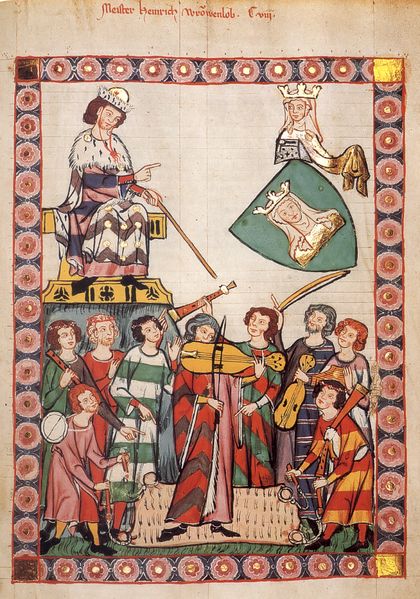
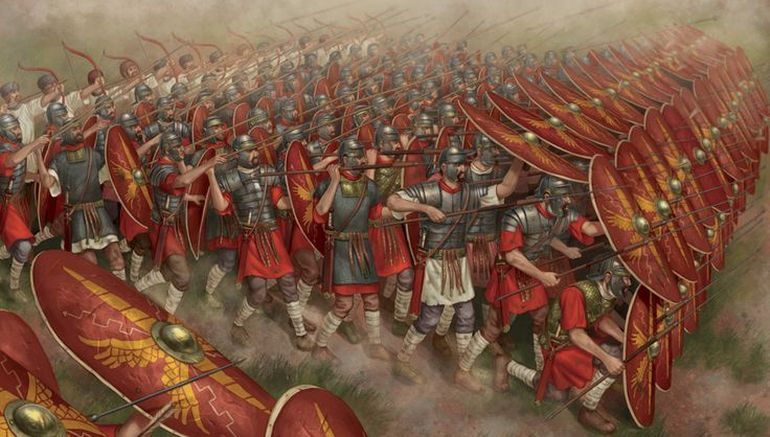

A nice post! Didn’t know pottage was baked into bread. Clever! 🙂
An interesting point relating to a life of hard labour: A boy who’d grown up on a farm went to college in the city, and got on the varsity team. He was surprised when his teammates gave up when they got muscle cramps or were exhausted. The farmboy had grown up in a place where you did your work or you starved – stopping because you were too tired didn’t make sense to him!
Very interesting! I love learning about all these little details. Doesn’t half make you wonder. Thanks for reading and commenting!
Pingback: The Life of the Medieval Lord – Richie Billing
Pingback: The Life of the Medieval Lord - Richie Billing
Pingback: The Ultimate Guide To Fantasy Armor | Richie Billing
Pingback: Killer Diseases of the Middle Ages | Richie Billing
Pingback: How To Make A Fantasy Map - The Essential Guide | Richie Billing
Pingback: Medieval Cannons: The Essential Guide | Richie Billing
Pingback: A Guide To Siege Warfare - Richie Billing
Pingback: How To Create Your Very Own Living Breathing Fantasy World - Richie Billing